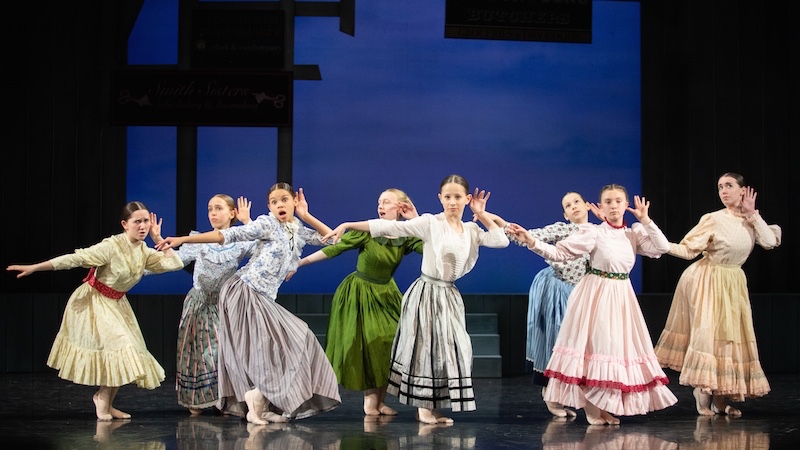Words by Bengi-Sue Sirin.
If you happened to read my recent interview with the London Children’s Ballet about their upcoming production of Anne of Green Gables, you would know how extremely excited I was to see it. The big day finally came yesterday – Saturday 28th May – and I took myself to the Peacock Theatre with an Anne-like spring in my step. Sitting in on rehearsals, meeting the cast and crew… These things gave me a chance to predict how marvellous it would be. But, I had to see for myself, would the finished piece live up to its promise?
Taking my seat in the theatre, I noticed a large number of young children and families. The excitement in the air brought flashbacks to my first ever ballet trip, the inevitable and charming Nutcracker with my Mum and Grannie-Annie when I was about 4. I am sure the little girl seated next to me with a tiara on was watching her first ballet. A lovely atmosphere.
Then, the lights dimmed and the theatre fell silent. Through the curtains slipped LCB Artistic Director Ruth Brill with five young dancers. Each of them read a very sweet paragraph about their connection with dance and their ambitions.. Then, we were treated to something I believe more ballet productions should incorporate to cater to wider audiences; a little demonstration of some mime movements, and an explanation of their symbolism. We were shown a little flourish of imaginary plaits over the shoulder, and told that whenever we spotted it on stage, it was in reference to she-of-the-ginger-plaits, our heroine Anne. Growing up, I had a very old family copy of the Ladybird Book of Ballet, and I remember it briefly summarised some of the universal gestures used in choreography – to indicate heartbreak, grief, joy… And now I am older, using British Sign Language in my day job, I appreciated this reminder of the gestural aspects of ballet all the more. I am sure many other audience members found this little touch just as illuminating.
Moments later, the ballet began. Dancers scurried to and fro in front of a train station backdrop with vim and vigour. Set, costume – all the aesthetics immediately transported me to late 19th century Prince Edward Island. Some hustle and a little bustle later, out bounded everyone’s favourite beplaited redhead: Annalise Wainwright-Jones in the role of Anne Shirley. She danced Anne exactly as Anne should be danced, all playfulness, elevation and dimpled charm. Wainwright-Jones’ style contrasted vastly with the stooped yet kindly character of Matthew Cuthbert, who Freddie Lovell portrayed with immensely skillful and considered characterisation. The newly acquainted pair set off for Green Gables in the most charming scene of the whole show, named for Anne’s imaginative appellation ‘the White Way of Delight.’ Here, dance depicted metaphor in ways that words cannot; a mini corps de ballet of blossoms spiralled in heavenly canon, bursting from Anne as a tangible reverie. It was stunning, and I am certain exactly what LM Montgomery would have choreographed.
The whole First Act was delightfully realised. Another standout scene for me was the one which choreographer Jenna Lee told me she envisioned immediately – Rachel Lynde’s Gossip scene. As with the blossoms, dancers at once literally and metaphorically represented gossip circulating Avonlea. Kitty Cox-Harrison brought Rachel to cattish and almost coquettish life, reminding me of the White Cat and Puss-in-Boots pas-de-deux in The Sleeping Beauty ballet. She is as playful as she is technical, in true Rachel Lynde style. In another notable characterisation, Alice Stallion danced the firm but fair Marilla Cuthbert with an authoritative grace. Her measured tempos and sharp lines were cleverly at odds with Anne’s irrepressible pace and passion. There was a beautiful flashback scene to Anne’s tragic childhood where orphans juddered in a clump a lá Pina Bausch’s Rite of Spring. For lifelong Anne fans and ballet newcomers alike, the story told itself.
While Act One allowed the characterisation to tell the story, Act Two took the opposite approach. Each scene tightly packed in one of Anne’s many iconic scenarios, indulging strong actors with the opportunity to shine. Wainwright-Jones gave us a spectrum of Anne’s moods – from the stubborn to the devoted, and the compassionate to the studious. I really look forward to following her dancing career because to be so skilled at just 13 just blows my mind! John Holden demonstrated incredible stage presence, from the scowl of his abusive Mr Holden role to the comic insensibility of schoolteacherMr Philips. And I was struck by supporting dancer Bruno Cokeliss, whose height-to-elevation ratio defied all understanding I thought I had of gravity. Many of this young cast will inevitably go on to stage careers – but especially watch out for these three.
As Anne of Green Gables fans will know, the story ends on a sad note. Kind, sweet Matthew dies. Watching Freddie Lovell collapse into Anne and Marilla’s arms, I welled up with tears. And when Anne discovered that within the birthday parcel Matthew had been carrying was the dress of her dreams, I full on wept. But the tears were more happy than sad, because I felt that despite the sadnesses along the way, good had been done to Anne Shirley. By Jenna Lee’s thoughtful choreography; by the lively score of Gus Nicolson; the hues and textures of Elin Steele’s beautiful costumes; the whole of the London Children’s Ballet company – especially Annalise Wainwright-Jones; and the hopefully first of many artistic direction of Ruth Brill. Act One in particular allowed the story to breathe and allowed us to marvel in metaphor, much like Anne herself. I mentioned in the interview that I am picky about adaptations of texts so dear to my heart. And I am so thrilled that this production did Anne of Green Gables such good! It added to my love of the book and it enhanced my perception of what ballet can do for storytelling.
Header image: Alice Pennefather.
